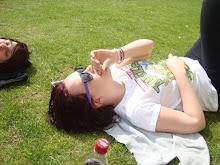I work evening shifts at the Halifax Share Dealing call centre - it is boring and slow. Fact.
I've decided to start bringing reading material in to pass the time between calls. This week I've been reading 'Digital Printmaking' by George Whale and Naren Barfield - I say this week, I just about managed to get through it in a night, it wasn't exactly what I'd call intense.
Considering it was published in 2001 it is shockingly basic. My favourite extract being:
"Computers usually come with a monitor (screen) for viewing, keyboard for typing and a small device called a mouse with one of two buttons on top. Whenever the mouse is moved a small pointer is moved across the screen, enabling the user to interact with the computer by clicking. All of the input devices (keyboard, mouse, scanner) and output devices (monitor, printer) are connected by cables to the main computer unit, a box with slots at the front and sockets at the back or side."
... That's right. I said basic.
Having said that though it does cover prepping an image for screen printing quite well, and also details various ways you can integrate intaglio prints such as etching into modern technology.
I'm not going to lie - a lot of the infomation covered is pretty irrelevant and the stuff that could potentially be useful doesn't go into enough detail. It's an awful book.
However.. One of the last chapters is titled 'Printmaking in the Age of Global Communication' and is split into 3 sections 'New Collaborations', 'The Virtual Museum' and 'The Future'. Again it's basic and outdated but probably the most relevant content for my project and it is interesting to compare what people in the past thought it would be like to today with reality.
New Collaborations brings the possibility of vast interactivity into play; Exploding Cell, a project involving artist Peter Halley enabled audiences to create one off originals of his work by randomising the colours of one of his works, placing their name alongside the artists and then outputting the piece. The book is also concerned with collaborations between very geographically dispersed artists. They refer to this as concurrent collaboration, whereby a series of sourced images are available, artists download them and alter them as they see fit then upload them back onto the website so they can then be developed by others. At the time this was merely a concept but the technical capabilities of the internet today means that this idea would be incredibly simple to set up.
The Virtual Museum toys with the idea of digital printmaking no longer needing to be represented on paper. Scanned in images and creative software mean that a work of art can be just as effectively presented on screen. There is also reference to wafer thin display technologies, or digital paper, that may render some traditional methods obsolete
Since I'd never heard of digital paper I had a potter round Google and there were only a few results I could really use. I did find a site with a couple of interesting short articles, saying that electronic paper can be used like wafer thin TV screens and inserted into magazines and newspapers just like leaflets.. but really, that's more to do with moving image than printmaking? It's an interesting idea, but I can't really see it's advantage in print over a regular sheet of paper..
The Future was a lot less interesting than I had hoped. Basically the said that digital printing technology would progress to no end, and that the longevity of traditional practices seemed uncertain and dependent on the creativity and preference of art practitioners... No shit.
They were almost cock on. Digital printing is constantly evolving into a better and more efficient version of itself, with both technology and software becoming more complex. However, in what is almost a rebellion to the vast amounts of pressure to utilise the crisp, cleanliness , the art industry has seen a rise in traditional printing in the past few years. With artists returning to hands on, 'more creative' means of practice as a medium for their work. But this sort of pattern can be applied to any creative industry. Animation, for example, is constantly fluctuating between amazingly accurate CGI capabilities and other more primative techniques. If you watch children's television today you'll see a lot of shows that are based around simply cut out animation - the techniques are the same as when they first came about, however technological advances allow us to apply them in a much more effective way, creating a revival of traditional methods.















































